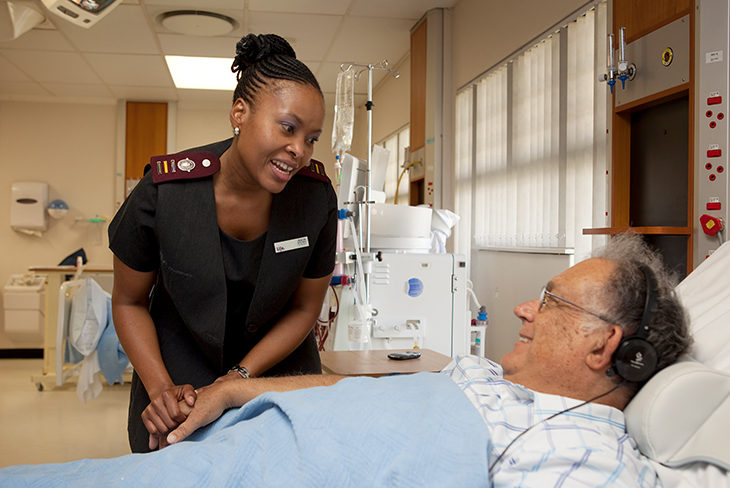Renal dialysis explained

What is renal dialysis and how can it save lives? Find out more about the procedure, different types of dialysis treatment and the purpose of the dialysis procedure.
Temporary or permanent damage to the kidneys, resulting in loss of normal kidney function, is referred to as kidney failure. End-stage renal disease is when the kidneys permanently fail to work.
There are two main types of kidney failure:
1. Acute kidney failure
This condition starts abruptly – usually in less than a few days – and is potentially reversible if the person is in otherwise good health.
2. Chronic kidney failure
This condition progresses more slowly – at least a few months – and it can lead to permanent kidney failure. There are five stages of CKD that refer to how well the kidneys are working.
In the early stages (1–3), the kidneys are still able to filter waste out of the blood. In the later stages (4–5), the kidneys must work harder to filter the blood and may stop working altogether.
‘End-stage renal disease means that the kidneys are no longer able to work as they should to meet the body’s needs in filtering out waste products, controlling the levels of fluid, electrolytes and waste product build up in the bloodstream,’ says Anette Gouws, Renal Dialysis Unit Manager at Life Robinson Private Hospital.
‘At that stage, patients either require dialysis or a kidney transplant to stay alive.’
What are the signs of kidney failure?
Anette says that signs of kidney failure include nausea, vomiting, loss of appetite, fatigue and weakness, sleep problems, changes in urination volume, decreased mental sharpness, muscle twitches and cramps, persistent itching, chest pain, shortness of breath and high blood pressure.
What does renal dialysis do?
Dialysis is a procedure that removes waste products and excess fluid from the blood when kidneys stop working properly. It often involves diverting blood to a machine to be cleaned.
Dr Mathews Thomas, resident nephrologist at the Life Renal Dialysis unit at Life Robinson Private Hospital, says it’s important to remember that dialysis only does 10% of the job of a healthy kidney.
‘Dialysis does not cure kidney disease. Patients with end-stage kidney failure will need to have dialysis treatments for life, unless they are able to get a kidney transplant.’
Read more about kidney failure and how dialysis works in our brochure.
What types of renal dialysis are there?
There are two types of kidney dialysis:
1. Haemodialysis
The dialysis machine filters blood through a dialyser, which has built-in safety checks to ensure the process is safe and effective. Each haemodialysis treatment lasts about four hours and is done three times per week.
2. Peritoneal dialysis
In this procedure, the blood is cleaned inside the body. ‘During the treatment, your abdominal area (called the peritoneal cavity) is slowly filled with dialysate through a catheter. The blood stays in the arteries and veins that line your peritoneal cavity. High concentrations of waste products and additional fluid are drawn out of your blood and filter into the dialysate,’ says Anette.
There are two major kinds of peritoneal dialysis (PD): continuous ambulatory peritoneal dialysis (CAPD) and automated peritoneal dialysis (APD).
‘Continuous ambulatory peritoneal dialysis is done without a machine. Automated peritoneal dialysis usually is done at home using a special machine called a cycler. This is similar to CAPD except that a number of cycles occur. Each cycle usually lasts one to one a half hours and exchanges are done throughout the night while the patient sleeps.’
Are renal dialysis patients able to travel?
‘It has become much easier for people receiving dialysis to travel, particularly those treated with peritoneal dialysis,’ explains Dr Thomas.
‘It would be easy for a person receiving PD to travel with their machine and fluids – or even to arrange to have the fluids made available to them at their destination. People travelling on long flights can even do their exchange on the plane.’
‘Life Renal Dialysis provides holiday dialysis at 30 chronic renal dialysis facilities in South Africa,’ says Anette. ‘Patients will need to contact the designated Life Renal Dialysis unit at least two weeks prior to commencement of treatment and the doctor and the healthcare team will assist with the plans and guide them on what information is required to book the treatment sessions.’
Are dialysis patients at higher risk of complications resulting from contracting COVID-19?
‘People who receive dialysis are considered to be at high-risk because they cannot self-quarantine at home,’ says Anette.
‘They need to commute and interact with the healthcare system more frequently than the rest of the population. Most of these people have other chronic conditions such as diabetes or hypertension and they may have a weakened immune system, which all contribute to their vulnerability.’
She says it remains vital that people living with renal disease continue with their regular scheduled dialysis treatments and take necessary precautions as recommended by their healthcare team.
To find out more about dialysis, watch this video in which Dr Brett Cullis, a nephrologist at Life Hilton Private Hospital, explains the various treatment options available.
The information is shared on condition that readers will make their own determination, including seeking advice from a healthcare professional. E&OE. Life Healthcare Group Ltd does not accept any responsibility for any loss or damage suffered by the reader as a result of the information provided.

